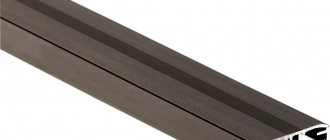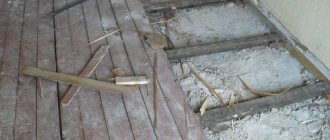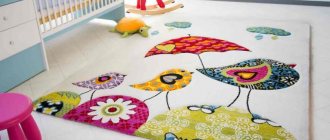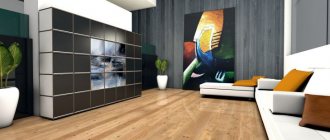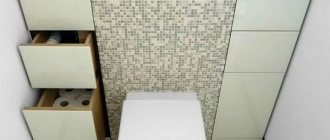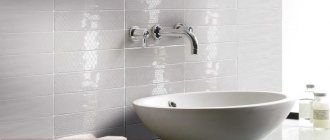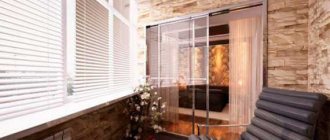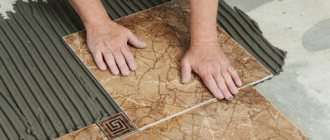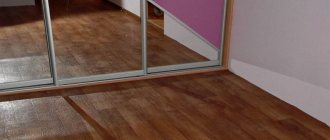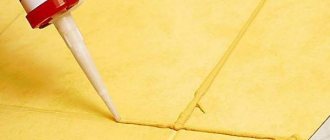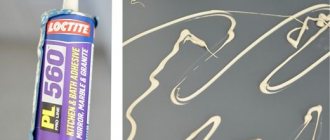PVC quartz vinyl floor tiles
Are there any features and differences in the installation of quartz-vinyl tiles Fine Floor and other types of floor tiles - porcelain tiles, tiles, PVC?
Are the labor and cost of the work similar or different? What's the point of such a tile? some kind of chopped linoleum
Svetlana-NM wrote: Are there any features and differences in laying quartz-vinyl tiles Fine Floor and other types of floor tiles - porcelain stoneware, tiles, PVC? Are the labor and cost of the work similar or different?
linoleum cut into squares must be laid on a perfectly level surface. The tile, by itself, forms a flat surface. IMHO tiles are more reliable than cut linoleum, but again, you can’t put tiles in rooms, but linoleum is mona!
quartz vinyl is laid like PVC tiles. PVC adhesives, flat base, A2 spatula (if the base is absorbent), etc.
valid7228 wrote: linoleum cut into squares must be laid on a perfectly level surface. The tile, by itself, forms a flat surface. IMHO tiles are more reliable than cut linoleum, but again, you can’t put tiles in rooms, but linoleum is mona!
They put it everywhere, that’s the point. The characteristics are good, not everyone knows.
Thanks a lot. Doesn't it last long?
Svetlana-NM wrote: They put it everywhere, that’s the point. The characteristics are good, not everyone knows.
For example, what is the point of putting it in the bathroom?? there is a need for tiles.
valid7228 wrote: what is the point of putting it in the bathroom, for example?? there is a need for tiles.
Why? It is not afraid of water and can be installed easily and quickly. We laid it out in one test room without glue to see how it looked. Even without glue it lies quite firmly
What I mean is that if the walls in the bathroom are made of tiles... what's the point of having a floor made of cut linoleum?
in the bathroom you need waterproof glue, and these are either solvent-based contacts or 2-k. LVT (designer) tiles are available in such a way that many people prefer them to ceramic tiles.
By the way, thank you. for the idea. I just have a hallway, hallway, kitchen, they have a complex configuration. If I bought linoleum as I wanted, then I would have to take about 4 meters of it, but how to bring it in, I kept racking my brains. and it would be difficult to cut it
valid7228 wrote: if the walls in the bathroom are made of tiles..what is the point of a floor made of cut linoleum?
Weird question. In your opinion, it turns out that walls and floors should be made of the same material?
Why are you being so derogatory?
natural (50x50 or 33x33). full in the form of lamellas, there is 50x50. There are good designs, there are 3D, wood, glass, metal, stone. Now I’ll see what I have from quartz vinyl.
gans gr wrote: in the bathroom you need waterproof glue
Yuri, the seller recommended Forbo 522 glue to us when we bought these tiles (a year ago). They used it in two rooms. Is this glue suitable for the bathroom?
I ran through Yandex. They sell only in Moscow, we don’t have them in Orekhovo-Zuevo, and the price is from 500 rubles (a la laminate) and up to 1000 for expensive parquet, stone and other patterns.
Howlin, sellers everywhere offer this glue and builders use it for everything, it’s very convenient. easily under household loads. if TP and tiles are not needed. I don’t allow it to be used in the bathroom (although a lot of people still use it). in the bathroom, if used, be sure to go through the perimeter with sealant and lay it without gaps.
gans gr wrote: I do not allow it to be used in the bathroom
Why?
gans gr wrote: be sure to seal the perimeter with sealant
Perimeter of the room? What sealant should I use? And what glue is better for the bathroom then?
522 is a dispersion; long-term exposure to water destroys it (it gets wet and loses its adhesive force), the tile will begin to lift the edges, etc. any sealant, the main thing is that it is smellier and less natural. contact glue is best neoprene, they are not afraid of water, ours is 233 (though it smells of solvents when working). When working outdoors, they use 2-k adhesives, but they are not so easy to work with (reactionary, i.e., limited lifetime, do not have an initial adhesive strength and if they are dirty, it is necessary to immediately remove the dirt; after setting, they can only be removed mechanically). But these adhesives can even be used to cover a swimming pool.
gans gr wrote: long-term exposure to water destroys
It's clear. Just what is “long-term exposure to water”? Constant splashes?
Howlin wrote: I see. Just what is “long-term exposure to water”? Constant splashes?
no, this is when water leaked under the covering and you didn’t notice and it is constantly there, absorbed into the base and the edges of the covering near the walls rise. Repairing it is long and difficult; you have to remove the tiles, wait for them to dry, and only then re-glue them.
Thanks again. I'll keep it on mind.
It’s not exactly like that in the photo, but it’s about water. gym, the screed was leveled with a pouring agent, the builders assured that there was a GI, they poured it, dried it, and laid it. In the spring, bubbles appeared, the glue was opened damp. moisture from below. By the way, customers have a lot of such idiots. There is only one option, remove the coating (most often it is thrown away), apply epoxy primer in 2 layers with a sprinkle of sand, level it again, glue a new coating, apply markings. and this only works if the floor level is at ground level (capillary moisture), but if the floor is below ground level, everything is more complicated there, you must protect yourself from pressure moisture. and the splashes from above are nothing to write home about
gans gr wrote: and the splashes from above are nothing to write home about
I think so too. The floor in my bathroom is much higher than ground level (4th floor). And if it floods too much, then IMHO, not only the glue will suffer
I've made a lot of noise here, I think they won't swear too much.
they laid it, according to the original plan there should be green instead of blue, but they did it in winter, the installation, as you can see, without baseboards, close to the plastic partitions, the office was just being built, the heating was at a minimum, so the water flowed slowly around the clock. leaving home, some bad person asked for a rag and it was sucked into the drain. In the morning there was ankle-deep water, all the outer pieces were swollen, I had to remove them because... The warehouse didn’t have the required color, and they didn’t want to wait from Holland, so they changed the walls and floors to blue. This is natural linoleum (wood flour). Just recently the guys sent a video from Saratov, there was also a flood in a kindergarten, only the design elements were swollen. but with PVC it’s easier. protect the perimeter and it will be ok.
Source: mastergrad.com
Typical Application
Household premises
Quartz vinyl floor tiles are unrivaled where durable, moisture-proof and wear-resistant coatings are required. A bathroom, shower room, toilet, kitchen, dining room, as well as a balcony or loggia are typical places for which practical polyvinyl chloride with the addition of quartz is chosen.
Utility rooms
Basements, wet warehouses, utility rooms - where concrete cracks after a few years, parquet absorbs moisture and delaminates, and the use of ceramic or porcelain tiles is impractical. Choose quartz vinyl tiles!
✔ Learn more about the benefits of quartz vinyl.
Temporary floor
Solid floors in museums, exhibition halls, galleries and other similar premises can be irreparably damaged at events with large crowds of visitors or demonstrations of heavy, large exhibits: monumental sculptures, interior elements, industrial equipment, cars or heavy special equipment. Free-standing PVC floor tiles have a prefabricated structure that will protect expensive floors during shows!
PVC tiles are laid directly on the subfloor, without a backing. Concrete base, plywood, fiberboard, chipboard, old linoleum or tiles - self-adhesive quartz vinyl fits perfectly with any materials if the surface is first leveled, treated with a primer, and dried thoroughly.
Material stock
We recommend purchasing 2-3 m2 more PVC tiles than the estimated area of the room. The material has to be cut off near the walls, this increases consumption. In addition, it is necessary to have a supply of vinyl in case of unexpected damage to the surface during operation.
Laying features
PVC tiles are laid at air temperatures above 18-20°C and pre-conditioned for at least 24 hours indoors. To accurately fit the design, you need to make cuts along the front side. Before installation, all skirting boards are removed or sealed on the outside with special tape. If you choose non-self-adhesive, you will need to additionally purchase PVC adhesive or double-sided adhesive tape. Floors can be used 48 hours after installation.
Main stages of installation
- Preparation of the rough base - leveling, processing, drying.
- Laying axial tiles, determining the central point of the floor in the room.
- Installation of the remaining fragments of the floor covering.
- The base and tiles are coated with glue, compaction is carried out with a roller or rubber mallet.
- Excess glue must be cleaned off so as not to contaminate the coating.
- Self-adhesive tiles are even easier to install - just remove the protection from the adhesive side.
PVC floor tiles - what they are and how to work with them
PVC floor tiles are a universal coating that primarily attracts buyers due to the durability of the material. This tile is widely used in commercial organizations, and also as an excellent covering for an apartment or house. What caused this interest? Everything can be easily explained, because such tiles are characterized by a huge range of design solutions, various colors, patterns, textures, and shapes. That is, it finds application in any interior style.
A little about PVC tiles
PVC vinyl floor tiles are designed for installation even in rooms where there are high levels of humidity.
This aspect distinguishes it favorably from laminate, cork floors, linoleum, and parquet. Not only is it not afraid of water, but in addition it prevents the formation of mold and mildew.
It is impossible not to mention the aesthetic indicators that PVC floor tiles have: the photo is clear proof of this. When laying such tiles, you can use your imagination and get plenty “creative” - lay them out chaotically, in a checkerboard pattern, in rhombuses. And using different colors, you can create original combinations, for example, lay out figures in the center of the room according to the principle of the children's game Tetris.
Important: since the tiles cut well, you can do appliqué - the end result will be an interesting figure.
It should also be noted that if you wish, you can buy elegantly designed tiles that realistically imitate modern parquet and marble. For example, to perfectly resemble parquet, PVC tiles are made in the form of planks. It is this fact that allows craftsmen to lay it so that it has maximum similarity with parquet patterns: “herringbone” or “deck”.
PVC floor tiles for garage flooring
GarageTek plastic flooring was developed for high traffic and high traffic areas, making it ideal for garages.
EXPERT OPINION
Vladimir, installation foreman at GarageTek
Is there an option to quickly install a garage floor without unnecessary mess?
They will help you solve the problem of installing a garage floor in a short time and with a minimum of dusty work. Various color options and the possibility of combining them will give the floor a unique look. Using tiles of different colors, you can, for example, lay out a “chessboard” on the floor or visually highlight a car parking area. But this is just one of the flooring options offered by GarageTek.
Floor tiles made of PVC (polyvinyl chloride) are attached to each other using special locks provided by the design, forming a continuous flooring. The basis for laying such a coating can be cement, asphalt or any other smooth base. Depending on the weight of the car, you can select the coating of the required thickness in order to optimize the mechanical impact. It should be noted that coatings can have varying degrees of roughness - this is especially important for inclined surfaces and garage driveways.
We typically install plastic sheeting in just one day. In rare cases, the timing may change after our garage expert analyzes your floor.
Cover colors: black, yellow, gray and dark gray (in stock)
Other colors - upon request
The floor can be made of tiles in one color or a combination of colors with different designs
Advantages of PVC tiles
Vinyl floor tiles boast remarkable properties:
- durability – a multi-layer specific composition, developed by scientists, ensures a long service life of the tiles. For example, the top protective layer can withstand about 10 million steps, without loss of quality or color. And a special UV layer reliably protects the design from unwanted discoloration;
- environmental friendliness - we can confidently say that in the world of vinyl coverings there is no safer material, confirmed by the results of tests;
Important: vinyl tiles have received the necessary certificates, so they can be installed in residential areas.
- versatility - this type of tile is successfully used on both floors and walls. Plus, it has a good degree of elasticity, which means it can be mounted on curved planes;
- ease of cutting and laying - an excellent property that allows you to cut curved sections;
- practicality - resistance to lateral impacts, shock-absorbing and thermal insulation characteristics, absence of the effect of a rattling floor;
- self-adhesive PVC floor tiles simplify repairs by eliminating the process of applying glue.
This list is far from complete, because vinyl tiles are also resistant to fire, household chemicals, non-slip and antistatic.
Structural features of the floor covering
The material is a multilayer “sandwich”, in which each level has its own functional characteristics:
- The lower base and middle layer are composite components, which contain PVC plastic, quartz sand, and fiberglass. Layers are responsible for the density and strength of the coating.
- An aesthetic layer applied by photo printing. It has a variety of textures and colors.
- The last top layer is a polyvinyl chloride film. This is protection against thermal influences, mechanical shocks and other things. The thicker the layer, the stronger the coating.
Important! The price of the product directly depends on all factors. PVC flooring has different layer thicknesses, which determines the scope of application of this material.
The production process for making floor coverings is quite complex and requires attention, compliance with standards and norms:
- After loading granulated PVC into a special bunker, the raw material is melted under the influence of high temperatures, then poured into molds;
- To give strength, granules are mixed with fiberglass and sand;
- Cooling is the next operation of the cycle;
- Notching, cutting to shape and size, shrinking and final hardening complete the entire preparatory process.
All that remains is to join the layers, apply the design, the top layer of plastic and the lamella are ready for implementation. The coating is repeatedly tested for strength, structural integrity and undergoes a lot of tests to determine suitability.
Installation recommendations
Of course, the installation of PVC tiles begins with a preliminary stage, that is, with the preparation of the base.
Before starting the range of work, paint, grease, dust and similar contaminants should be removed from the floor. It is also important that PVC floor tiles can be laid on different surfaces, so it is reasonable to indicate some features:
- wooden floor - you need to make sure that there are no nails protruding anywhere, and the boards should be leveled with a special compound;
- tiled floor - you need to level the level of the tiles and the joints between the tiles.
Important: if necessary, you can apply a leveling layer to the entire surface, let the floor dry, sand and clean it from dust;
- concrete floor - and here the leveling mixture comes in handy: with its help, potholes and cracks are filled. At the time of laying the tiles, the humidity should not exceed 2.5% - this is a very significant point. Then the surface must be vacuumed, completely removing dust.
So, if the base is prepared, you can begin installation; for this you will need certain tools, in particular a tape measure, a blade knife, a metal square, a pencil, as well as a spatula for applying glue, a smooth rubber roller, and a sponge.
Rubber crumb tiles are perfect for flooring in residential areas. This coating is durable, it does not break, break or wear out. We'll tell you more about it here: https://pol-master.com/pol-pokritiya/plitka/rezinovaya-plitka.html.
First, “beacon” tiles are glued along the axes that determine the central point of the floor. And from them you can “dance on.” This advice must be taken into account if PVC tiles for the floor are chosen as the material - then the installation will be correct and the result will be good.
Important: the center line can be either parallel to the side walls, or selected according to the parameters of a particular room.
As for the glue, it should be applied evenly using a notched trowel, leaving no untreated areas of glue or clumps. Naturally, you need to use glue that is suitable specifically for the type of tile in question.
Direct installation of vinyl tiles:
- the placement of the tiles exactly along the center line, of course, in accordance with the direction of the arrows that are on the reverse side;
- if installation is not carried out on a flat base, it is advisable to use a household hair dryer - the mounted PVC floor tiles then acquire greater plasticity;
- the tiles are laid tightly, without leaving gaps or displacements;
- the laid tile is rolled with a rubber roller;
- excess glue is removed with a damp sponge or a sponge that has been moistened with an alcohol-containing composition;
- after 30 minutes, re-roll the previously laid area with a rubber roller.
An interesting option is PVC floor tiles that are self-adhesive; their use greatly simplifies the installation process. It is clear that no glue is needed for installation - the protective film simply peels off.
Quartz vinyl tiles are closer in origin to the mineral quartz than to PVC. This gives the tile extraordinary strength, almost zero abrasion, fire safety, and moisture resistance. You can read about the features of laying such a coating in the material: https://pol-master.com/pol-pokritiya/plitka/kvarcvinilovaya-plitka-dlya-pola.html.
Many people are concerned about one more question, namely, how do PVC tiles and warm floors combine? The answer is clear - these tiles can be installed on any type of heated floors.
Important: the recommended temperature is +28 degrees.
- checking the laid areas, as well as carefully inspecting the edges and corners for quality gluing;
- removal of construction waste, sweeping the floor. You can wash the floor only after 24 hours;
- Furniture can be installed after two days, having previously glued felt pads to the legs.
Features of laying tiles
Laying PVC tiles is a much less labor-intensive process than installing most floor coverings. However, it also requires careful preparation of the surface, as well as special care when installing starting rows. Depending on the type, there are three main technologies for laying vinyl flooring.
Various design options for laying PVC coating, arrangement of elements and appearance in the interior:
Tools used
Most of the tools that may be needed when laying PVC tiles are at the disposal of any self-respecting home craftsman. No specialized or expensive devices are required. This is another advantage of PVC coating. For ease of use, some tools are undergoing slight modernization:
- metal one- or one-and-a-half meter level, ruler or rule. Used for support when cutting. To prevent the metal tool from sliding on the surface of the tile, double-sided tape is glued to its back side and lightly sprinkled with talc, plaster or flour.
- stationery or construction knife with replaceable blades;
- tape measure, square;
- rubber hammer - if the coating will be laid with end locking connections;
- lapping is an ordinary wooden block on which several layers of felt are stuffed. Used for self-adhesive tiles. Special rollers for rolling are sold on the market, but for small volumes of work their purchase is unjustified;
- notched trowel - if the coating is laid on glue. The tooth should be triangular, small 1x2 mm;
- construction hair dryer - necessary if you need to lay tiles bypassing pipes. It is used to heat the material, after which it is much easier to cut.
Important!
Cutting PVC coating is quite easy. An incision is made on the front side. After this, the material is bent along the cut line and the inner layers are cut. To make bending easier, it is recommended to first heat monolithic and thick-layer tiles with a hair dryer.
Preparing the base
Cement-sand screed and other sheet materials can be used as the base material. They must be pre-treated with a primer (especially the screed) to normalize moisture absorption. In some cases, installation on old flooring, such as tiles, is allowed. However, all intercellular spaces must be carefully sealed at the same level as the tiles.
The best option is to use a new subfloor made of moisture-resistant plywood with a thickness of 15-18 mm. The slabs are laid with offset seams. Gaps up to 2 mm wide are left between them to compensate for thermal expansion. The seams are carefully sealed with acrylic sealant.
Laying process
- On glue.
Special glue is applied to the surface of the base with a notched trowel. It is necessary to distribute the mixture evenly over the entire contact area. Depending on the type of adhesive, tiles can be laid immediately after application or after some time of 2-5 minutes. After laying the PVC tiles on the glue, they are carefully tapped with a rubber hammer or rolled and ground. The purpose of these manipulations is to completely get rid of the air under cover.
- With a lock.
Regardless of the type of interlocking connections, installation is carried out from the far wall. If necessary, the fasteners are cut on one side (if the first tile is located in a corner, on both sides). They retreat from the wall to the width of the expansion joint - 2-3 mm. Subsequent elements of the composition are joined to the first, driving the locking joints, especially the end ones, by lightly tapping with a hammer.
If you want to become the owner of a high-quality floor covering that is not afraid of moisture, then PVC floor tiles can become your informed choice. This modern high-quality material has a number of undeniable advantages. Laying technology allows you to install the tiles yourself. We invite you to get acquainted with the features of this floor in more detail.
.
PVC tile flooring is a stylish solution for any interior
Read in the article
Self-determination of humidity levels
As already mentioned, before laying tiles on concrete, you need to determine the humidity - for this purpose you can use a moisture meter. If it is not there, you need to do the following:
- put a napkin on the cement, then a plastic film;
- the edges of the film are glued to the screed with tape;
- you need to put a heavy object on top;
- after 15 hours you can check the condition of the napkin: if it is dry, everything is fine, if it is wet, you will have to wait a little while with installation.
Basically, PVC floor tiles have positive reviews, because if you properly install high-quality material, it will last a long time.
Source: pol-master.com
PVC floor tiles
Polyvinyl chloride (PVC) tiles have gained a strong position in the flooring materials market. Until recently, linoleum was one of the most popular, inexpensive and reliable floor coverings. It has been successfully used for both residential and office buildings. But its main disadvantage was its large weight and bulkiness. Delivering linoleum to the house was a very difficult task. Another disadvantage of this very popular building material was that if a small area was damaged, the linoleum had to be completely replaced.
Floor tiles, compared to linoleum, do not have the disadvantages of linoleum, while maintaining its advantages. We can say that PVC tiles are high-quality linoleum, cut in a certain way. The sizes of such quadrangles can be different.
The main advantage of polyvinyl chloride tiles is hygiene. This is an excellent solution for utility rooms in apartments. In addition, this is an extremely budget option: compared to other types of floor tiles (for example, ceramics), the price of PVC tiles is much less. In addition, it has a very aesthetic appearance: there are many color options for this material. In addition to living spaces, these tiles perform very well in outbuildings, garages and basements.
PVC tiles can be used to create temporary floor coverings. Thus, the use of this coating helps to keep floors with expensive coatings in good condition (for example, museums, exhibitions with large attendance and heavy exhibits: for example, with mining equipment, pet exhibitions).
Reviews on the choice of PVC flooring
PVC tiles have disadvantages, but they are not significant. It is worth noting that the quality of the future coating directly depends on how competently you select construction and finishing materials. Experts prefer to choose domestically produced products, since, unlike Chinese or Korean fabrics, they fully comply with all the necessary requirements.
There is a wide variety of PVC flooring available in different colours, shapes and sizes
And:
- They have excellent quality;
- They look beautiful;
- Do not deteriorate until the end of their service life.
When purchasing, you should not focus only on the design of the tiles, since in this case you will not be able to find a quality product. It is very rare to find truly conscientious manufacturers who do not hide hundreds of shortcomings behind bright packaging. How to make the right choice and not make mistakes?
It is worth carefully examining the packaging, which should indicate the wear resistance class, the level of abrasion, the material from which the layers of the fabric are made, the main parameters of PVC plates, guaranteed service life, information about the presence or absence of an additional layer.
A quality certificate is required.
To ensure that the floor covering is of truly high quality and pleases with its appearance, it is worth using a number of recommendations from experts. Materials are purchased 10% more than required. The reserve is needed in case of deformation of the canvases when cutting to decorate the floor near the walls. It is best to carry out installation at a high temperature, which will allow the adhesive composition to be evenly distributed and also dry quickly, ensuring high-quality adhesion. It is not advisable to install standard wooden skirting boards, since the best option would be to choose PVC sheets, which are not only easier to work with, but also look more aesthetically pleasing.
The main advantages and disadvantages of PVC tiles
The undoubted advantages include:
- Easy to transport. Unlike bulky linoleum, it is easy to carry it in transport and bring it into the room.
- Compared to linoleum, PVC tiles are significantly superior in strength.
- Wide variety of colors. You can make any patterns from the tiles; choosing colors, arranging it in a unique pattern.
- Moisture resistance.
- If one or more tiles become damaged or come off, they can be re-glued or replaced.
- PVC tiles have good soundproofing properties.
- You can cut it into separate shapes and fold the floor pattern as you wish.
- Exact geometric dimensions. It is very easy to use and does not require additional adjustment. Due to the exceptional ease of installation, you can handle this work yourself, without involving craftsmen (and this is an additional cost savings).
- Relatively unpretentious, easy to maintain (the most common wet cleaning).
However, it must be said that this material is not without some drawbacks.
- Additional costs associated with purchasing primer.
- The price of PVC is the same as that of good quality laminate. But definitely lower than parquet!
- For small towns there is a relatively small assortment.
But these shortcomings are not critical. PVC tiles are an excellent solution for any type of premises.
Pros and cons of the material
PVC tiles have a number of advantages :
- Low cost universal floor covering.
- Convenient transportation of material (compared to large-sized roll coverings).
- Easy to install.
- PVC tiles ensure safe movement on them, since they are not prone to slipping.
- A variety of color shades and compositions. Tiles can be used to create both monochromatic coating patterns and unique design solutions.
- Polyvinyl chloride tiles are moderately hard and elastic.
- PVC tiles are not exposed to moisture or corrosion; they don't crack.
- This coating provides good sound insulation.
- Damage to one of the tiles requires replacement of the entire covering. Simply cut out the damaged tile and replace it with a new one.
However, there are a number of disadvantages :
- Since PVC tiles are made from synthetic materials , it cannot be called an environmentally friendly material.
- The service life is relatively short - up to 10 years.
- Tiles are damaged under the influence of solvents, acetones
Procedure for laying PVC tiles
- Level the floor, saturate it with primer and wait until it dries.
- We attach beacon tiles along the axes that form the center of the floor surface.
- Focusing on the beacon tiles, we glue the remaining ones.
- To stick PVC tiles, you can use any adhesive suitable for these purposes (for example, PVA). Glue is applied to the tile and it is pressed tightly to the surface. For better adhesion, we also roll it with a roller. Re-rolling with a roller is recommended after 30 minutes. You can use double-sided adhesive tape.
- The stage of gluing the next tile is similar. The tiles are laid end to end. If we want to cut the tile (for example, to create a semblance of parquet), it is advisable to first heat it with a hairdryer.
- After installation, the tiles should be allowed to dry for several days. At the end of this period, we install the furniture. The work is finished!
Some useful tips
- Let's determine the size of the room. Let's calculate the number of square meters in accordance with the area of the room. We buy 2-3 m2 more than what we calculated, since the tiles near the walls will have to be cut.
- Before gluing, you need to keep the tiles in the room for at least a day. Do not neglect this acclimatization period!
- The optimal temperature for gluing is approximately 20 0 C.
- It is advisable to remove the skirting boards before installation.
- To better fit the pattern, it is advisable to cut the tile on the outside.
Video on laying PVC floor tiles:
Size selection
Polyvinyl tiles are available in rolls, in the form of square or rectangular panels.
The following sizes of piece products are considered the most popular:
- 30x30 cm;
- 50x50 cm;
- 65x65 cm.
It is advisable to choose large panels for spacious rooms. Small and medium tiles are perfect for small rooms. When choosing the thickness of the material, keep in mind that the durability of the finished coating will depend on this parameter. A thin product can quickly lose its aesthetics. If you plan to lay PVC tiles in a corridor or rooms with high traffic, it is advisable to take a closer look at options with a thickness of 5 mm. It is best to give preference to heterogeneous materials. They will last longer.
Before purchasing, you need to calculate the number of tiles required. To do this, you need to multiply the length and width of the room to find the area of the room. After this, you can go to the store, choose the tile you like and find out its size. To calculate the number of tiles required, you need to divide the area of the room by the area of one panel.
The question of how to choose PVC tiles often arises among people who decide to renovate their apartment. Most people, when purchasing material, give preference to a beautiful design, not paying attention to the technical parameters. This is the wrong approach. When choosing flooring, first of all you need to look at the product labeling. As a rule, it indicates the wear resistance class, the number of layers, the type of base and the degree of abrasion.
Linoleum tiles have several wear resistance classes:
- 21-23 (household);
- 31-33 (commercial);
- 41-43 (special).
The higher the degree of wear resistance, the stronger and more reliable the material will be, but such products will also cost more. You also need to pay attention to abrasion. When marking, this indicator is denoted by the Latin symbols T, P, M, F (in descending order of stability).
In addition, do not forget to evaluate the external characteristics of the product. The range of materials is quite wide. If desired, you can choose options with geometric images and plain variations. When choosing a color, you need to focus on the design of the room, shades of wallpaper, furniture and decor.
To decorate small rooms, give preference to light flooring. Tiles in white, beige and cream tones can visually expand the space. Light material is a winning option for small rooms, dark material is relevant for decorating large rooms. When choosing tiles, do not hesitate to feel the products. This way, you can buy a sample that is suitable both in shade and calibration, and in texture.
Variations in PVC tile patterns
The most common designs are those imitating natural stone (granite, marble), wood or metal. With careful gluing, you can achieve the complete illusion of a continuous floor covering. It looks very nice in a large room. A new product among PVC tiles is materials with the illusion of a three-dimensional pattern. This type of flooring transforms a room simply fantastically!
An option that makes installation even easier is self-adhesive tiles. In this case, just peel off the tape - and the front of the gluing work is ready!
Caring for PVC-coated floors is very simple. You can simply wash the floor using detergents.
After laying the floor, two days later (the time required for the glue to dry), the floor is washed with a mild detergent, then rinsed with warm water.
For everyday care of floors with PVC tiles, regular washing with a special detergent is sufficient. If signs of wear appear on the floor surface, a protective mastic can be applied to restore shine.
Some tips for removing stains.
- Moisten stains of organic origin carefully with a washing or bleach solution (do not rub into the surface!), and then wipe with a rag. To remove marks from pens, markers and other difficult-to-remove marks, use a gum turpentine substitute.
- Treat rust stains with a special rust remover or oxalic acid.
- Important! Never use products that contain soda, alkalis or have abrasive properties to care for PVC floors.
Vinyl Flooring Manufacturers
Moisture-resistant vinyl tiles of class 43 with decors imitating the texture of various types of wood, natural stone, parquet. The Aquaflor range also includes a unique one with a middle layer of marble powder.
Exclusive PVC tiles at a price from the manufacturer Tarkett - a stylish combination of wood or stone textures.
Nothing extra, only quality and safety - Decoria vinyl floor tiles. Free delivery throughout Russia!
Quartz vinyl flooring ReFloor - affordable price, increased mechanical strength with a total thickness of only 2 mm!
Anti-slip surface and improved performance characteristics - adhesive quartz vinyl is suitable for home and office, as well as a new product for 2020 - vinyl tiles with bright wood-like decors.
Eco-friendly PVC floor tiles Art House - containing quartz sand, no plasticizers or formaldehyde used in production - high-quality coating for floors and walls.
- Polymer coating for garage floors is sometimes called “self-leveling floors” or “poured floors.” Our polymer composition can be laid on so-called heated floors in the garage.
Installation of GarageTek polymer floors is carried out within one day. Within 2-4 hours after completion of the work, you will be able to walk on the new floor, and after 24 hours you will be able to park your car in the updated garage.
EXPERT OPINION
Is the polymer floor suitable for parking, is it resistant to wheel spikes?
It is important to prepare a high-quality foundation - a good screed, poured according to all industrial standards from concrete of a grade not lower than M300. Thin-layer seamless coatings based on polyurea are resistant to the destructive effects of heavy vehicle weight, thorns, temperature changes, dirt, dust, water, chemicals, gasoline, oil, falling heavy objects and others.
We eliminate defects
An extremely important point is the elimination of defects. If the base of the tile is excessively moistened, or if there is an excess or, conversely, a lack of adhesive, swelling may appear on the floor surface. To eliminate swelling, the tiles are carefully peeled off, lubricated again with mastic and firmly re-glued. After this, tap it with a rubber hammer. If the cause of swelling is an air bubble, the tile can be carefully pierced, the air released and ironed through thick paper with a warm iron.
What can you do to make your PVC coating last as long as possible?
- Make special backings from soft material for the legs of chairs, tables and cabinets.
- Avoid getting small stones and dirt on the floor. To do this, you should place special rugs at the entrance.
- Rubberized carpets should not be used on PVC-coated floors. Rubber casters on furniture should be avoided.
- Excessively hot objects, a lit cigarette, sharp or very heavy objects can also damage the coating.
Source: bouw.ru
Related discussions
Garbage bin in the kitchen - hide it in the closet or not?
Gray interiors: yes or no?
Island, yes or no?
To soundproof the walls or not? Brick Khrushchev.
- Like
- Save
Laboratorio Creativo di Vladimir Lamfadel
Certainly! It’s best to walk on plastic... no one argues... stretch the film over your head “for harmony”... install plastic windows with plastic slopes, and cover the bathroom with a plastic slats))) and may you be happy!
- Like | 2
- Save
Alena Chekalina Design Studio
it all depends on the budget and tasks.
Vinyl has previously been used extensively in public buildings. They also used to like to put asphalt in houses instead of concrete screed. Well. to each his own. We do not use such coatings in our projects. But if the question arises about how to cover the floor in the garage, let’s say. we will think about it.
What goal do you pursue by giving preference to vinyl? Do you like the fact that there is expensive, indestructible plastic on the floor? Or does it fit into your budget? Or do you like watching advertisements and like it when people make money off of you? or.
- Like | 2
- Save
- Likes: 1
- Save
Alena Chekalina Design Studio
A friend of mine has an entire apartment in vinyl. There was a serious flood - the whole apartment was ankle-deep. After drying, the coating remained unchanged. If you need these qualities of a material, then vinyl is an excellent material for your needs.
- Like | 2
- Save
NataliProject
Dear Lyusya, please note that in the example you provided there is practically no heat-insulating layer. This means that the floor temperature will be close to the temperature of the concrete floor, so the floor will be “icy” by default. I don’t think you will be happy with the prospect of trampling on a cold floor anywhere.
- Like
- Save
Galina Makhrova
I wouldn't be so categorical. During Soviet times, most people used linoleum. In fact, it is the same material only much more expensive and better. It is imperative to provide heat-insulating material under the quartz vinyl to avoid problems with your feet.
- Likes: 1
- Save
PVC tiles - advantages and disadvantages
PVC or vinyl floor tiles have different pros and cons. It is important to consider them before purchasing laminate flooring for your apartment, so that the use of the coating brings joy and satisfaction from the purchase. Details in this article -
PVC or vinyl floor tiles have different pros and cons. It is important to consider them before purchasing laminate flooring for your apartment, so that the use of the coating brings joy and satisfaction from the purchase.
Details in this article.
What are PVC floor tiles
Structure
Advantages and disadvantages
Conclusion
1950s The advent of vinyl flooring
Vinyl tiles are often called “linoleum cut into strips,” which is in no way applicable to modern material, but accurately describes a product invented in the USSR for mass use. Dye, polyvinyl chloride and stabilizers were mixed together, rolled out into sheets 2-3 mm thick, cut into 30x30 cm squares. This is what the first PVC tiles looked like, which are still in some houses: lost color, hardened, but in excellent technical condition!
In the early fifties, the USSR began mass construction of apartment buildings, which required millions of square meters of floor coverings. The simplest to produce, very cheap and durable vinyl flooring in rolls and tiles has become the most popular finishing material. Despite the decorative squalor.
What are PVC floor tiles
The name itself speaks of the artificial origin of the material - plastic has firmly entered everyday life and a variety of finishing materials are produced from it. Polyvinyl chloride (PVC) flooring comes in a variety of forms. Most often these are regular geometric shapes - rectangles and squares.
The parameters of the first option are length up to 1 m, width up to 18 cm. The second option is 50*50 cm. The thickness of one lamella is from 1 to 7 mm, depending on the size of the layers.
Structure
Like any other non-natural flooring, vinyl laminate consists of several layers.
Namely:
- Substrate. It is usually profiled to create better adhesion to any surface. Careful preparation of the base is required before laying such material.
- Laminate body. This is a plate made of plastic, moderately hard, to impart stability to the raw material and bear the main loads. Locking joints are immediately installed on it if the tile is intended for laying a floating floor. If they are not there, the fixation method is adhesive.
- Stabilizing layer. Fiberglass or stone chips are added to the artificial material to create reinforcement between the layers. Thus, the tile receives good rigidity and redistribution of emerging loads.
- Decorative layer. Vinyl laminate flooring can look like natural floorboards with a natural wood grain pattern. And also have a look that is completely unrelated to wood. Usually this is paper.
- Protective layer. Typically, these are resins made from a polyurethane composite. They protect the tiles from abrasion
Quartz vinyl laminate is popular due to its many qualities. Its advantages can compete with natural floors in many respects.
Advantages and disadvantages
In everyday life, PVC laminate is popular. There is undoubtedly a place for it in apartments and private houses. Why:
- Laminate or PVC tiles are absolutely inert to moisture. Unlike wooden floors and laminate flooring with an MDF base, polyvinyl chloride coating is not threatened by the effects of moisture - the formation of mold, the development of fungus.
- PVC tiles are easy to transport and lay - important qualities for a building material. When laying it, no dirt or dampness is created. At the same time, there is no need to take out the furniture and completely free up the area for flooring. It is possible to operate the premises immediately after installation.
- A variety of colors will allow you to create beautiful compositions on the floor.
This cannot be done in the case of wooden floors, where the natural pattern is the priority. - A high degree of wear resistance allows us to talk about a significant service life. Floor tiles are not at risk of mischief from pets and children. She is not threatened by heels or point pressure from furniture legs. It will not split, will not become covered with cracks, will not go in waves.
- The material itself is not cold, but it is not forbidden to lay a variety of heated floor systems under it.
- PVC tiles have high maintainability. If damage does occur, then one area can be easily changed to another, without dismantling the entire area of the laminate.
- Ultra-easy care. The tiles do not require special means, unlike parquet or traditional laminate. She is not afraid of steam mops and vacuum cleaners.
- The biggest disadvantage of vinyl laminate flooring is the fear of low temperatures. Since the base is “plastic”, at low temperatures and especially sub-zero temperatures, swelling of the laid floor is possible due to the expansion or contraction of individual boards or slabs.
- Another disadvantage is a separate type - PVC tiles with an adhesive backing. For such coatings, very high-quality floor leveling is necessary, because... the slightest changes in height will be extremely noticeable. Plus, the adhesive method of laying vinyl laminate requires additional costs for the glue itself, which equates its cost to PVC laminate with a locking joint.
In terms of the number of advantages, PVC tiles are a unique flooring material. However, nothing is perfect and there are also disadvantages. What are they:
- For lovers of eco style, the coating is of no value - it is unnatural. And although polyvinyl chloride does not emit harmful substances into the atmosphere, you should carefully choose the manufacturer of this product - counterfeits are possible.
- High price. Due to its high performance characteristics, high-quality coating is expensive. In addition, the cost of the binder and the cost of floor leveling work are taken into account.
- Polyvinyl chloride is sensitive to temperature changes. Therefore, it is not recommended to install it in hallways or unheated rooms. The structure can crack at sub-zero temperatures.
Considering that there are few disadvantages compared to the advantages, PVC tiles pass the test of popularity with honor.
Scope of application
Polyvinyl chloride tiles are used for covering floor surfaces in rooms for any purpose. It can be used when installing a warm water floor indoors, which is especially important for private country buildings and apartments located on the ground floors. PVC coating can also be used for finishing:
- Bathrooms and kitchens. The material will be a wonderful addition to these rooms. Thanks to its harmlessness and high resistance to high humidity, the tiles will retain their aesthetics for a long time in difficult conditions.
- Bedrooms, living rooms, corridors. Due to its decorative nature, the material will fit perfectly into any room. A wide range of products allows you to choose flooring to suit any room interior.
- Children's room. This cladding does not emit harmful substances during operation, so it is perfect for finishing rooms where children live. PVC tiles for a children's room will be the best solution due to their environmental friendliness.
- Commercial properties, office premises, warehouses and garages. Plastic tile flooring is durable, making it suitable for use in industrial workshops, exhibition centers, and retail outlets.
For finishing living rooms and offices, you can purchase household tiles that have excellent aesthetic qualities, but mediocre technical parameters. In rooms with average traffic it is allowed to use semi-commercial material. Floors in high traffic areas should only be finished with commercial cladding.
If you plan to lay such a coating in a production workshop, then you should take a closer look at specialized linoleum tiles. It may have fire-resistant properties, resistance to acids or alkalis, depending on the modification.
